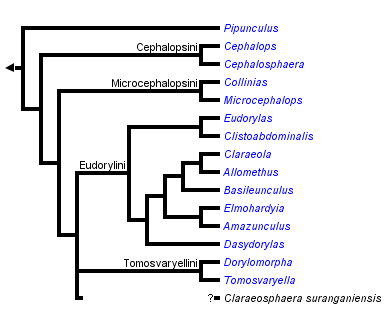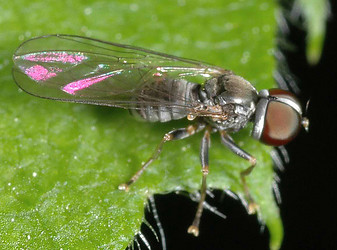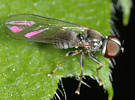Pipunculinae
Jeff Skevington


This tree diagram shows the relationships between several groups of organisms.
The root of the current tree connects the organisms featured in this tree to their containing group and the rest of the Tree of Life. The basal branching point in the tree represents the ancestor of the other groups in the tree. This ancestor diversified over time into several descendent subgroups, which are represented as internal nodes and terminal taxa to the right.

You can click on the root to travel down the Tree of Life all the way to the root of all Life, and you can click on the names of descendent subgroups to travel up the Tree of Life all the way to individual species.
For more information on ToL tree formatting, please see Interpreting the Tree or Classification. To learn more about phylogenetic trees, please visit our Phylogenetic Biology pages.
close boxIntroduction
With 1268 species, this is by far the largest subfamily of big-headed flies. The 15 genera are relatively easy to distinguish with only the Eudorylini posing difficulties. See Skevington and Yeates (2001) for a key to genera.
Characteristics
Pipunculinae are easy to distinguish from Chalarinae and Nephrocerinae. In Pipunculinae the hind margin of the eye is straight (deeply excised medially in Nephrocerinae), the ocellar bristles are reduced (distinct in Chalarinae), the head is spherical (hemispherical in Chalarinae) and the margin of the mesonotum and scutellum have no strong bristles (strong bristles present in Chalarinae).
References
Skevington, J. H. and D. K. Yeates. 2001. Phylogenetic classification of Eudorylini (Diptera: Pipunculidae). Systematic Entomology 26: 421-452.
Title Illustrations

| Scientific Name | Eudorylas |
|---|---|
| Specimen Condition | Live Specimen |
| Identified By | Jeff Skevington |
| Sex | Female |
| Life Cycle Stage | adult |
| Copyright |
© Steve Marshall

|
About This Page

Agriculture and Agri-Food Canada, Ottawa, Ontario, Canada
Correspondence regarding this page should be directed to Jeff Skevington at
Page copyright © 2005
 Page: Tree of Life
Pipunculinae.
Authored by
Jeff Skevington.
The TEXT of this page is licensed under the
Creative Commons Attribution License - Version 3.0. Note that images and other media
featured on this page are each governed by their own license, and they may or may not be available
for reuse. Click on an image or a media link to access the media data window, which provides the
relevant licensing information. For the general terms and conditions of ToL material reuse and
redistribution, please see the Tree of Life Copyright
Policies.
Page: Tree of Life
Pipunculinae.
Authored by
Jeff Skevington.
The TEXT of this page is licensed under the
Creative Commons Attribution License - Version 3.0. Note that images and other media
featured on this page are each governed by their own license, and they may or may not be available
for reuse. Click on an image or a media link to access the media data window, which provides the
relevant licensing information. For the general terms and conditions of ToL material reuse and
redistribution, please see the Tree of Life Copyright
Policies.
- First online 02 November 2005
Citing this page:
Skevington, Jeff. 2005. Pipunculinae. Version 02 November 2005 (under construction). http://tolweb.org/Pipunculinae/54638/2005.11.02 in The Tree of Life Web Project, http://tolweb.org/







 Go to quick links
Go to quick search
Go to navigation for this section of the ToL site
Go to detailed links for the ToL site
Go to quick links
Go to quick search
Go to navigation for this section of the ToL site
Go to detailed links for the ToL site